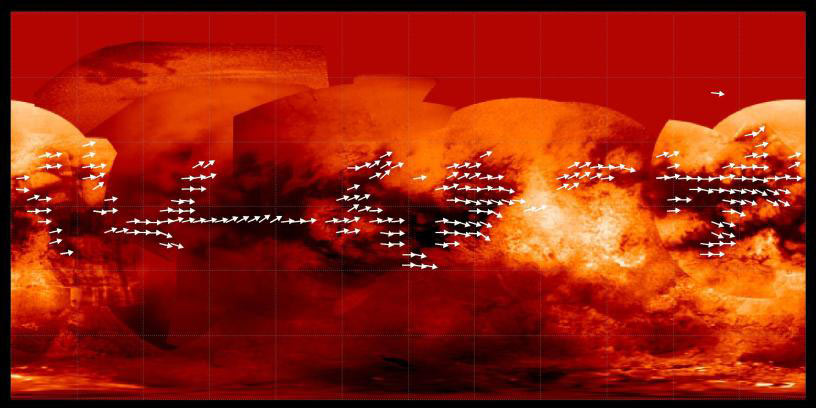Giant Sand Dunes on Titan Shaped by Backward Winds

Gusty windsthat blow in reverse of prevailing weather on Saturn's largest moonTitan appearto shape some of the moon's odd equatorial sand dunes, a new studyfinds.
Huge dunesof tiny particles of carbon cover more than 20 percent of Titan'ssurface. A particular band of these dunes ? within about 30degrees latitudeof the equator ? have been puzzling to scientists. Their shape suggeststheywere formed by winds blowing sand from west to east, yet climate modelspredictthe wind there is almost always blowing in the opposite direction.
A new model byTetsuya Tokano at the Institut f?r Geophysik und Meteorologie inGermany couldhelp solve the mystery. The research is detailed in the journal Aeolian Research.
Mysteriouswinds
According tothe model, winds in that region do typically point toward the west,except fortwo times a year, around each equinox, when strong gusts switchdirections andblow toward the east. Although these Titan winds are much less frequent, theyseem todominate the formation of sand dunes beneath them. [Map of Titan's winds.]
"Ittakes some minimum (threshold) wind speed for sand to start moving, soeven thoughwinds are more frequently westward, if the sand responds only to thestrongest winds,then the orientation of the dunes will reflect that of the rarer butfastereastward winds," wrote physicist Ralph Lorenz of John HopkinsUniversityin a Perspectives article published July 30 in the journal Science.
Thestrangely oriented dunes on Titan were first observed by the NASA'sCassini probe in 2005 and came as a surprise to researchersexpecting thereverse based on the prevailing westward winds in the upper atmosphere.
Get the Space.com Newsletter
Breaking space news, the latest updates on rocket launches, skywatching events and more!
Basicprinciples of planetary physics maintain that the winds of any planetor moonshould balance out globally, or else cause a shift in its rotation,Lorenzsaid.
"Ifthere were only eastward winds everywhere, it would accelerate Titan'srotationinfinitely and slow down the wind, but this is not the case," Tokanosaid.
Reverse direction
Tokano'sTitanwind model resolves this apparent imbalance by tying the culprit windtoperiods that are very brief during the spring and autumn equinoxes.
Thoughoccurring only every 14.5 Earth years (a Titan year is 29.5 yearslong), theseasonal reversals are so strong that their winds exert a dominatinginfluenceon the shape of the perplexing sand dunes.
"Thedunes appear to record only the blast of (W-E trending) windsat equinox. Even though the wind is usually E-W, the averagewinds are not enough, it seems, to move the sand much," Lorenz said.
Scientistsattribute the winds' turbulent mixing to solar energy, whichdisproportionallybathes the lunar surface when Titanfaces the sun head-on during each equinox.
- Photos:The Surface of Titan
- ExoticLife Could Sprout from Titan Chemistry
- Images? The Rings and Moons of Saturn
Join our Space Forums to keep talking space on the latest missions, night sky and more! And if you have a news tip, correction or comment, let us know at: community@space.com.
Zoe Macintosh is a science writer who covered human spaceflight, astronomy and science for Space.com in 2010. She also covered general science for Space.com's sister site Live Science. Zoe studied English literature and physics at Smith College, where she also wrote for the Smith Sophian. Her work has also appeared in the National Association of Science Writers website.









